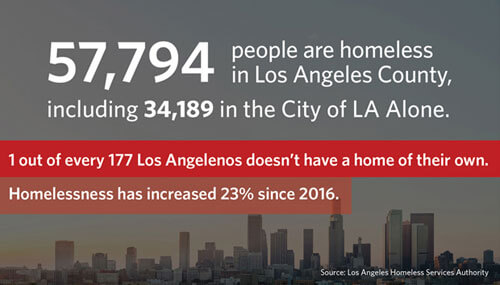Entrepreneur Insight
Entrepreneurial Strategies to House the Homeless
By Daisy Lin
A real estate developer thinks outside the box to help tackle the homeless crisis.
You don’t normally associate entrepreneurs with potential solutions to homelessness. That’s exactly what Joe Patel, managing partner of Nikki Investments, a real estate development group, wants to change.
“If we don’t become part of the solution then who do we turn to? You can’t just rely on the government,” Patel says.
The recently released 2017 Homeless Count shows the homeless population soared 23 percent last year in Los Angeles County, and there are now 57,794 people living in cars, shelters, and on the streets.

“Several hundred people die on the streets of LA County every year. So finding permanent housing for our homeless neighbors is always urgent,” says Chris Ko, the director of homeless initiatives and Home for Good at the United Way of Greater Los Angeles, which works with East West Bank and the Los Angeles Chamber of Commerce on action plans to end homelessness.
These partnerships played an important role in the creation and passage of Measure H, a quarter-cent sales tax, which will raise $355 million annually for 10 years, and Proposition HHH, a $1.2-billion bond measure to build housing for the chronically homeless. In a dramatic move, voters approved both measures, and now, Ko shares, private developers will play a crucial role.
“The funds from Prop HHH will primarily be granted to private developers with the resources needed to not just build permanent supportive housing but to ensure that they’re properly operated once residents move in,” Ko says.
Building homeless housing at the speed of business
That’s where entrepreneurs like Patel come in. He and Nikki Investments have developed a model that he says can be replicated nationwide. Working with East West Bank’s commercial real estate banking division, they purchase vacant or underutilized property, carry out extensive refurbishing and upgrades, and then lease it out to trusted organizations that specialize in providing housing, medical and mental health services, and education to the homeless.
“The process is to create win-win scenarios. For us, an empty building doesn’t generate any revenue. A vacant building doesn’t serve the purpose of the community either, so matching a tenant that needs to acquire a building is part of the process,” Patel says. “Once we know the needs of the service provider, we can then accommodate what needs to get done at the speed of business.”
Finding the right permanent supportive housing provider
Patel partners with Rev. Richard Reed, the executive director of First to Serve Inc.—a state certified and licensed non-profit organization—to provide three supportive housing facilities in Los Angeles. On any given night, First to Serve provides up to 700 beds for the homeless, and offers comprehensive medical, mental health, and substance abuse treatment, counseling for domestic violence, social services, and various forms of housing for the homeless.
“They are the outcasts of society. Nobody wants to touch them, nobody wants to deal with them,” Reed says. “We give them that loving tender care of supportive wrap-around services that consists of substance abuse and mental health treatment, life skills, case management, and treat them as if they are somebody.”

"My future is bright. I’m excited for new things to come."
Somebody like Ronnisha Allmond is a good example. A soft-spoken single mother currently living with her daughter, Love, at a First to Serve family shelter in South LA, Allmond was homeless while she was pregnant and slept in a car. She and her daughter moved to the shelter in 2016, where she got counseling to treat her anxiety, and they now live in their own room in an apartment-like setting.
“Thank god for coming here,” she says. “They help me fill out my paperwork for my housing, I have a therapist that actually cares, and I love the environment here, especially for my daughter.”
Allmond plans to move into permanent housing in a few months with First to Serve’s help, and to get her job back at the post office.
“You are part of helping someone pick up the cross and walk again. It’s priceless,” Reed says.
Putting out a call to developers
More of this type of housing is in demand. The Los Angeles County Homeless Services Authority estimated that 14,000 more units of permanent supportive housing countywide are needed to house the homeless. Through Proposition HHH, the city will contribute up to a third of the cost for permanent supportive housing projects.
“Permanent supportive housing is a fairly new solution, but it’s one we know works. It’s 90 percent effective and 43 percent cheaper than leaving someone on the streets,” Ko explains.
“It’s a much needed approach, and we are committed to helping to fill this critical need in the community,” says Robert Lo, executive vice president and head of commercial real estate banking at East West Bank.
Patel is putting out a call to his fellow real estate developers, to step up and lend a hand to the homeless. “I might not be able to solve the whole crisis, but whatever units I can add on any given day, that’s more than what was there before,” Patel says. “So I like to see extra space, if it can be used for a homeless solution, then let’s try to see if the numbers fit together.”
“It’s now on all of us to ensure that these units get built,” Ko says. “We all need to do our part to educate our communities and our neighbors about the transformative effects of permanent supportive housing… It’s time to say yes to housing.”
Sign up for the Reach Further Newsletter
We’ll keep you in the know about the latest US-Asia business news and trends.
Suscríbase al boletín Reach Further
Lo mantendremos informado sobre las últimas noticias y tendencias comerciales entre Estados Unidos y China.

